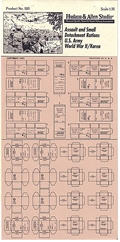5-in-1 and
Assault Lunch Rations
According
to "Special Rations for the Armed Forces" of the QMC Historical
Studies, the 5-in-1 ration was introduced in 1942 for motorized
combat groups operating in desert areas, providing rations for five
men for one day. This concept later became the basis of the 10-in-1
package, and the menu was similar to its successor. Though extensive
procurements of the 5-in-1 ended in 1943, the ration did continue
throughout the war. When the 10-in-1 program ended in 1948, the
5-in-1 pack was developed as the "Ration, Small-Detachment,
5-in-1" and was used in Korea.
The
Assault Lunch was was a late-war design that came out of the needs
of the amphibious campaigns in the Pacific. Soldiers needed something
packing a lot of calories for the period between the beginning of
an assault and the time when supplies could make their way to the
soldiers ashore. The resulting menu contained chocolate bars, caramels,
dried fruit (prunes and raisins), chewing gum, peanuts, salt tablets,
cigarettes, matches, and water purification tablets. They were packaged
in a resealable plastic film packet, and 45 of these packets were
sealed in a 6 1/2 gallon metal drum for shipping and distribution.
Hudson an Allen say the Assault Ration was phased out after the
Korean War.
The
Quartermaster Museum was unable to provide me with additional material
or images, so I cannot vouch for the accuracy of the Hudson and
Allen Assault and Small Detachment Rations product, except to say
they have done their homework on their other products and provide
the best items of the other rations types, so they've got a commendable
track record in my book. I would use the Small Detachment boxes
(dated May 1944) in Europe, Italy, or the Pacific, and the Assault
Rations in the Pacific.
5-in-1 and
Assault Lunch Rations Packaging
|
|
 |
| Product |
Hudson
& Allen Studio (1115): Assault and Small Detachment Rations,
U.S. Army - World War II / Korea
|
Number
of Items |
3
each of 2 versions of box-and-sleeve combination
4 of box top-and-bottom style with two-piece insert boxes
|
| Historical
dimensions |
not
available |
| Product
dimensions |
Carton
1:
17 1/2 x 13 x 10
Sleeve 1:
17 1/2 x 14 x 10 1/2
Carton 2:
17 x 12 x 10
Sleeve 2:
17 x 12 x 10
Carton 3 top
14 x 12 x 11
Carton 3 bottom:
12 1/2 x 11 x 10 1/2
Inner box:
13 x 12 x 5 1/4
|
| Material
and color |
Light
card stock; color is acceptable. |
| Instructions |
Yes |
| Markings |
Version
1 and 2 Carton and Sleeve:
FOOD PACKET
INDIVIDUAL
ASSAULT 1A
COLE PACKAGING, INC.
CLINTON, IOWA
14 Packets
WT 29.0 CU 1.1
fine print and stampings; markings are on four sides of sleeve,
two sides of carton.
Version 3 Carton Cover:
RATION
SMALL DETACHMENT
5 IN 1E
MENU 1
LOT 963
PACKED 5-44
WT 28 CU 1.2
STR. NO. 14-C-563
FOSTER-KANE INC.
DAYTON, OHIO
CONT. NO. 31-889
fine
print and stampings
Version
3, Inner Boxes:
MENU 1
FIRST
(or SECOND) HALF OF 5 RATIONS
fine print and stampings
|
| Comments |
Excellent
appearance and easy construction. Make sure you have the correct
sleeves and cartons for each of the two styles.
The inner boxes of the third style carton are nicely done; you
can leave a flap open or closed. |
|
Finished
Product
|
 |
| Final
Thoughts |
Very
good. While I can't vouch for the dimensions, the markings look
good. An interesting choice that one does not see often in dioramas. |
|












